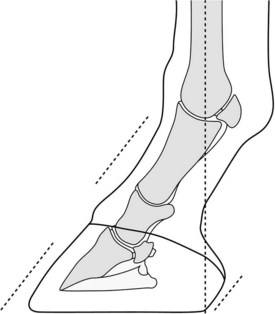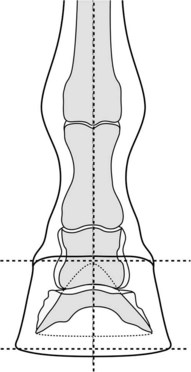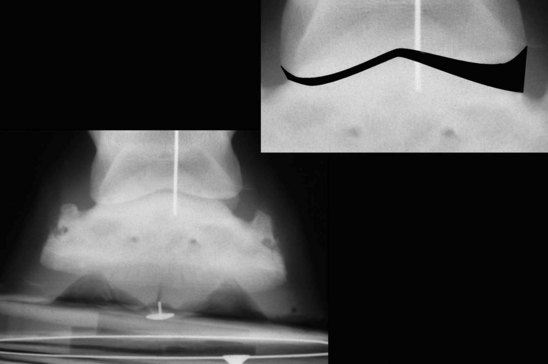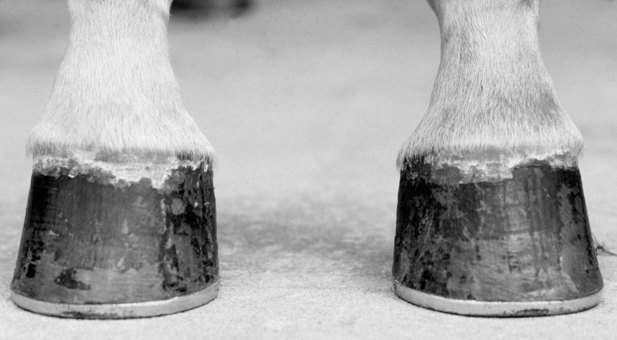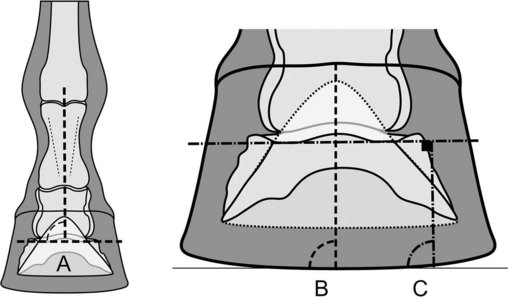Chapter 27 The Foot and Shoeing
 Foot Balance, Conformation, and Lameness
Foot Balance, Conformation, and Lameness
Foot Function
Optimum Balance and Conformation
Static Balance and Conformation
Viewed from the lateral aspect, the foot-pastern axis should be straight; that is, the dorsal hoof wall should be parallel to the dorsal surface of the pastern, and the angle of the heel should approximate that of the dorsal hoof wall (Figure 27-1). The angle of the dorsal hoof wall and the foot-pastern axis to the ground is variable, but it frequently is cited as 50 to 54 degrees in forelimbs and approximately 3 degrees steeper in hindlimbs.53 Other studies report higher or lower means and variable relationship between the angles of the dorsal hoof wall of the forelimbs and hindlimbs.54,55 In domestic horses the length of the hoof wall has been approximately linked to the weight of the horse (7.6 cm for 360 to 400 kg; 8.25 cm for 430 to 480 kg; 8.9 cm for 520 to 570 kg).53 In feral horses the toe length ranges from 6.7 to 8.9 cm14,54 but is independent of weight.54 In domestic horses with either trimmed or shod hooves, the length of the heel should be approximately one third that of the toe,2,55 but in feral horses it varies with the terrain.14 An imaginary line that bisects the third metacarpal bone (McIII) should intersect the ground at the most palmar aspect of the weight-bearing surface of the heel.56,57
On a lateromedial radiographic image the dorsal hoof wall should be 14 to 20 mm thick depending on breed58-60 and parallel to the dorsal surface of the distal phalanx. The angle made by the distal solar border of the distal phalanx with the ground ranges from 2 to 10 degrees.58,60,61 The center of rotation of the DIP joint is palmar to the center of the ground surface of the foot. Viewed from the dorsal aspect, a line bisecting the metacarpal region should bisect the phalanges and foot, so that the foot is approximately symmetrical, including the mass of foot on either side of the line and the heights and angles of the walls.1,3,57,61 The medial quarter is frequently steeper so that the medial wall is shorter than the lateral wall.2,62,63 A line drawn between any two comparable points on the coronary band should be parallel to the ground, and a vertical line bisecting the McIII should be perpendicular to a line drawn across the coronary band or the ground surface of the foot62 (Figure 27-2).
Imbalance and Poor Conformation
Mediolateral Imbalance
Mediolateral imbalance can be induced by applying a wedge pad to elevate the medial or lateral side of a foot or trimming a foot unevenly. The coronary band is no longer parallel to the ground or perpendicular to the sagittal axis of the limb. The horn tubules of the dorsal hoof wall are no longer oriented in the sagittal plane. Dorsopalmar radiographic images demonstrate that the DIP joint space is narrower on the side of hoof elevation, and the middle phalanx slides to the lower side.43 In addition, the condyle of the middle phalanx on the elevated side of the foot moves palmarly, in effect causing the distal phalanx to rotate on the middle phalanx so that the dorsal margin of the distal phalanx rotates away from the elevated side43 (Figure 27-3), but the horse has the appearance of being toed toward the elevated side.1
Rotational deformities, such as toe-in and toe-out conformation, alter the position of the ground surface of the foot in relation to the midsagittal vertical axis of the limb. Toe-in conformation causes the foot to wing out during the flight phase of the stride,1 and if the limb does not deviate from a vertical axis, the foot lands on the lateral heel quarter and breaks over at the lateral toe. Toe-out conformation causes the foot to wing in during the flight phase of the stride. The foot lands most frequently on the lateral heel quarter, as with toe-in conformation (see Figure 4-13). Breakover is less consistently directed than breakover in horses with toe-in conformation. Angular deformities, including base-wide and base-narrow conformation, and varus and valgus deformities also alter the position of the ground surface of the foot in relation to the ideal vertical axis of the limb. If an angular deformity (e.g., varus) is severe enough that the distal aspect of the wall at the quarter is axially directed, it will become underrun. Rotational and angular deformities may occur in combination, complicating the picture.
Clinical Identification of Hoof Imbalance
Mediolateral Imbalance
Visual inspection should note the position of the entire limbs to identify angular or rotational deviations more proximally in the limb that may have repercussions for the foot (Figure 27-4). Visual inspection of the foot on the ground should note rotational deformities of the metacarpophalangeal joint and placement of the foot in relation to the sagittal axis of the limb. The hoof capsule should be inspected closely for asymmetry of the coronary band. This is frequently a strictly visual inspection, but graphing the height of corresponding medial and lateral points on the coronary band provides objectivity that can highlight an imbalance and provide a record for future comparison.55,88 The medial and lateral walls should be inspected for flares and evidence of an underrun heel, lipping at the coronary band, and even spacing between the growth rings.
A dorsopalmar radiograph is the only means to assess the relationship between the hoof capsule and the phalanges (Figure 27-5). Overt imbalance can be detected on routine dorsopalmar radiographs, but detection of more subtle changes requires strict technique because apparent radiological imbalance can be readily induced artificially. Both feet must be weighted equally, because unilateral weight bearing induces mediolateral asymmetry and rotation of the interphalangeal joints.43 The foot must be allowed to assume its natural orientation to the rest of the limb, most reliably achieved if it is placed on a swiveling block. Deformation of the hoof capsule may be induced by rotation within the limb, which may change the angulation of the distal phalanx with the ground.89 The metacarpal region must be within 10 degrees of vertical in the frontal (dorsal) plane. The x-ray beam must be horizontal and centered on the midsagittal plane so that a wire marker centered on the dorsal hoof wall bisects the central sulcus of the frog on the radiographs. Neither toe-in nor toe-out conformation alters the radiological measurements of mediolateral balance if assessed in this manner.90,91 Interpretation of balance from dorsopalmar radiographs is usually based on examining either the relationship between the articular surface of the distal phalanx and the ground, which are ideally parallel, or the symmetry of the phalangeal joints, which should be of even width medially and laterally. When these appear to be in disagreement, I consider joint asymmetry to be more important because it is difficult to envisage a circumstance under which it is not harmful. In addition, interpretation of imbalance is more complex in horses in which the imbalance is chronic because the imbalance is associated with compensatory changes in hoof wall growth and also appears to be associated with movement of the hoof capsule in relation to the distal phalanx.
